反对声音自然主义 | Against sonic naturalism
At the end of last year, I had the privilege to be part of the best academic conference ever – full spoilers, it’s called Tuning Speculation, it’s broadly about sound, and its next iteration is happening in Bloomington, Indiana, in November 2018. Back then, I presented a bundle of largely incoherent gripes I have had with field recordings (as genre, practice, and aesthetic) ever since I picked up a dictaphone and started messing around with tapes in 2006. My talk was titled Postnaturalism, antinaturalism, unnaturalism: Pushing phonography beyond its field, and at some point video footage of it will be available online; for its largely improvised script, I drew on the work of some of my favorite sound artists to develop a few thoughts that I had already started outlining in an earlier podcast episode, and this blog post is an overdue attempt at taking stock of my own arguments, since these are still far from being material for a disciplined submission to the peer-review machinery. Feel free to disagree, for I might be wasting a couple thousand words taking down silent strawmen.
My main contention is that the practice of phonography and the genre aesthetics of field recordings have been (and, most troublingly, still are) consistently framed by a naturalist epistemology which, in many cases, reinforces an entrenched naturalist ontology of sound. Mine is a critique, rather than an outright rejection, of sonic naturalism – a comfortable mode of aurality that is too often unthinkingly defaulted to, and that in turn easily solidifies into a transparent ideology. After decades of representational critiques of naturalism in textual and visual media, the aural seems to have largely wiggled away from these accusations, and has hence become the privileged retreat for the naturalist onto-episteme. The reason behind this, I would argue, is that the affective experience of sound, combined with the unfamiliarity (and the resulting mythicization) of listening as a practice, lends the auditory sensorium to be easily construed as domain of an unmediated vibrational truth. I am still working on a convincing articulation of these arguments, and I am still reading up writing by the many others who have already argued similar points; yet, a few weeks ago, I stumbled across an exhibition that forced me to think once again about my favorite representation of sonic naturalism: the lonely high-end microphone, wrapped in a fluffy windscreen, and propped up on its tripod in a field.
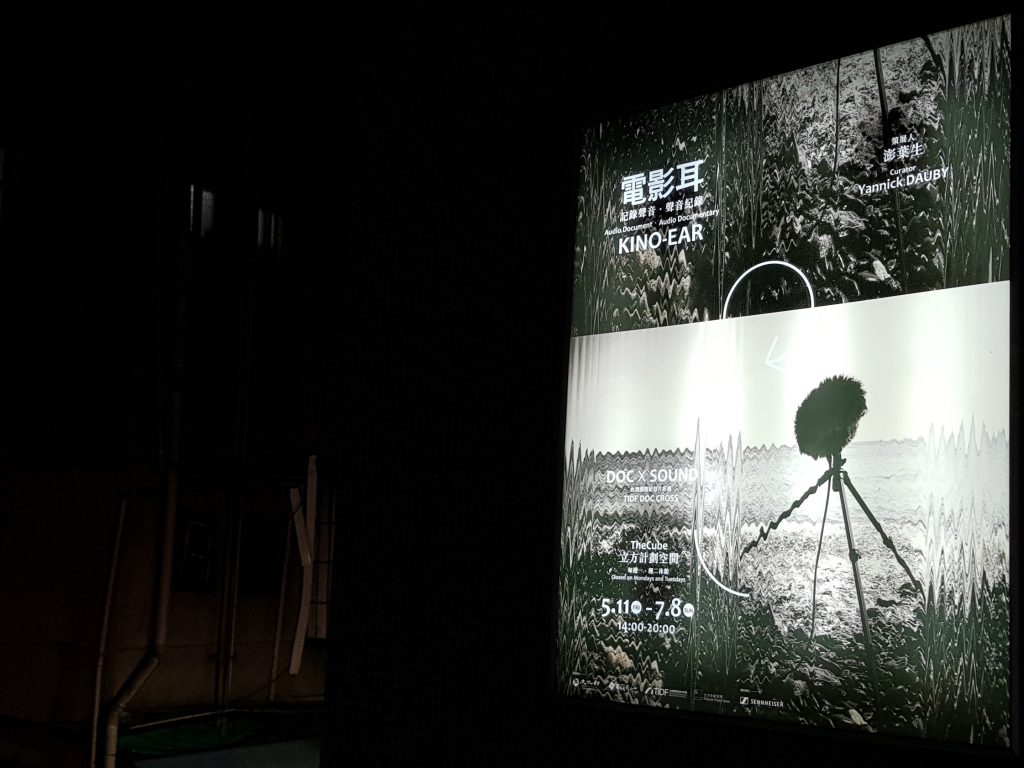
The catalyst precipitating this post were a couple of extended visits to KINO-EAR: Audio Document / Audio Documentary, a delightful exhibition curated by sound recordist and composer Yannick Dauby, open to the public until early July 2018 at TheCube Project Space in Taipei. Co-organized by the Taiwan Film Institute and the Taiwan International Documentary Festival, KINO-EAR features a selection of audio works from Taiwan, Japan, Hong Kong, France, UK, the US and Australia, most of which are based on recorded sound. As the curatorial notes highlight, experiencing the KINO-EAR exhibition is a markedly aural affair: “a profusion of sound-woven stories, sceneries and events, and auditory descriptions […] unfold from the listening space and the display of diverse media such as documents and photographs”. While sound is tasked with weaving scenes and narratives, the reliance on a vocabulary of description and documentation to frame it should already raise a flag regarding the main claims (of representational accuracy, immediacy and truth) that are all too effortlessly attached to sound. As I make my way up to the exhibition space, the title of Susi Law’s recording of Hong Kong hawkers installed in the stairwell seems to offer a reasonable advice: “Come and listen even though you are not going to buy it!”
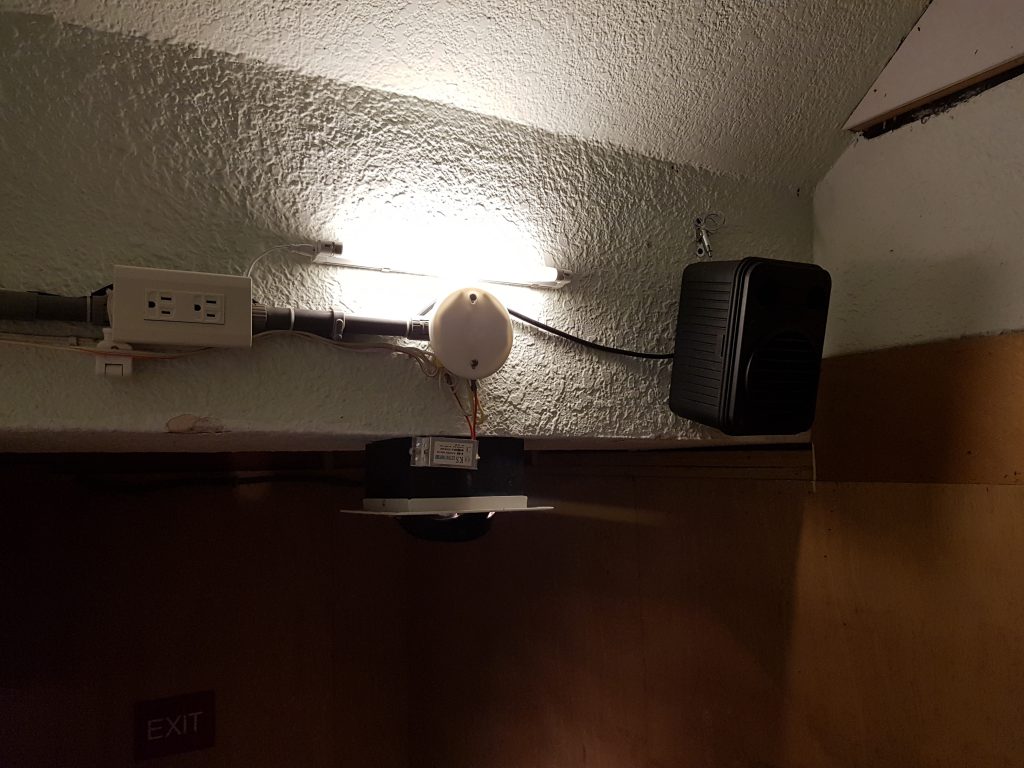
Right at the entrance of KINO-EAR, accessible exhibition paratexts offer a quite coherent discourse about the practice of recording, foregrounding the figure of the recordist – not a great framing if you’re a fan of non-human agencies:
Recordists are people who observe the world with audition rather than vision. Through microphones and headphones, they interpret their sonic environment: the sound recording tools sometimes act as filter, sometimes as an enhancer, revealing details and/or creating a distance. The recorder allows to keep traces of acoustic events, in a non-neutral ways since it recall to us the sounds that have been modified by the position in space and time, the gestures and the equipment of the recordists.
Here the naturalist epistemology is quite evident, and might resonate with overtones familiar to visitors acquainted with anthropological critiques of observation and interpretation. While the recognition of the partial and constructed nature of any kind of representation in a time-based medium such as sound (shaped by acts of filtering, enhancing, cropping, distancing) is a welcome bit of self-reflexivity, the idea that sounds are modified by the non-neutral practice of recording seems to fall back on a naturalist ontology assuming acoustic events to exist somewhere in a neutral, original, natural state.
The sort of sonic naturalism I’m struggling to outline perspires quite strikingly from the five definitions of keywords pinned at the entrance of the exhibition: audio-naturalist, soundscape, acoustemology, sonic journalism, and audio document/audio documentary. Audio naturalists are here described as a subset of recordists who focus on natural sounds, and whose aesthetic approach “depends on the technical quality as well as the ‘purity’ of the recorded environment”. Soundscape, defined in opposition to sound environment, is “a process of listening to the place” that harks back to the phono-hygienic obsessions of R. Murray Schafer. Acoustemology is explained through the words of Steven Feld in terms of acoustic knowning as “the ways in which sound is central to making sense, to knowing, to experiential truth”. A quote by Peter Cusack predicates sonic journalism on the idea that “all sound, including non-speech, gives information about places and events and that careful listening provides valuable insights different from, but complimentary to, visual images and language.” Audio documents and documentaries, finally, are defined by Yannick Dauby himself as more or less constructed narrations through which recordists share their perceptual experiences. The largely interchangeable meanings of these keywords, as they are marshaled by the KINO-EAR exhibition, help boiling them down to a workable definition of what I call sonic naturalism: the recording of soundscapes as a way of capturing reality and producing journalistic or documentary knowledge accessible through dedicated listening.

As an auspicious sign of a successful curatorial endeavor, some of the artworks escape, contradict and challenge the exhibition’s own framing devices. I sit down in the first room of the exhibition, a darkened space with two speakers and black cushions strewn across the floor that is dedicated to a selection of audio documentaries. Coincidentally, the work reverberating around me is Steven Feld’s Voices in the Forest, a 1983 multitrack recording that has been central in illustrating ad disseminating Feld’s own formulation of acoustemology. Resulting from years of fieldwork among the Kaluli people, Feld’s composition highlights the possibilities offered by collaborative and dialogic practices of recording, interpreting and representing the rainforest, which, “as a co-inhabited world of plural sounding and knowing presences was, most deeply, a listening to histories of listening” (Feld, 2017). These intuitions would warrant a re-examination of field recordings as a whole, but instead, when framed by multiple keywords that they were aimed to counter or upend – including, most notably, the concept of soundscape itself – Feld’s pioneering work is somehow reduced to a colorful ambience: the participatory approach to local epistemologies of listening, the aspect of acoustemology that is perhaps Feld’s most important contribution to the anthropology of sound, disappears behind the uncanny snaps of woodcutting interspersed by Kaluli songs.
The following couple of audio documentaries – Gael Segalen’s Empty Cab and No Ticket by Jeanne Robet and Pali Meursault – introduce a more outright embrace of intimate feelings and narrative composition. While the former sketches a short vignette of a taxi ride in San Francisco, the second revolves around a first-person narration by a passenger traveling on a train from Italy to France, and it buries sparse elements of naturalist phonography under layers of electronic processing, resulting in a suspenseful and intimate emotional narrative. It would be a disservice to criticize these works as paragons of naturalism, and their focus on precarious identities and urban mobilities brings a refreshing twist on the genre. On the contrary, Yannick Dauby’s own audio documentary 山林 Forest, a twenty-minute collage of spoken testimonies overlaid with “beautiful soundscapes, peaceful representations of wilderness” recorded on the mountains of Northern Taiwan, offers a textbook example of naturalist epistemology at work: the voice of an aboriginal man is undercut by Mandarin translations, and both testimonies end up drowning the subtle sonic backdrop in a didascalic descriptions of aboriginal living in forests that “still keep stories of their ancestors”. Similarly, Waterland 水上樂園 by Taiwanese artist Yen-ting Hsu 許雁婷, a fifteen-minute work about life in Taiwan’s coastal areas, intersperses comfortable snippets of crashing waves with fragments of local people talking and some occasional Taiwanese pop song hovering in the background: at its best, it feels like unreflexive eavesdropping on blurry everyday life scenes in places that can, as a woman’s voice puts it, “bring you closer to nature, to the environment”.
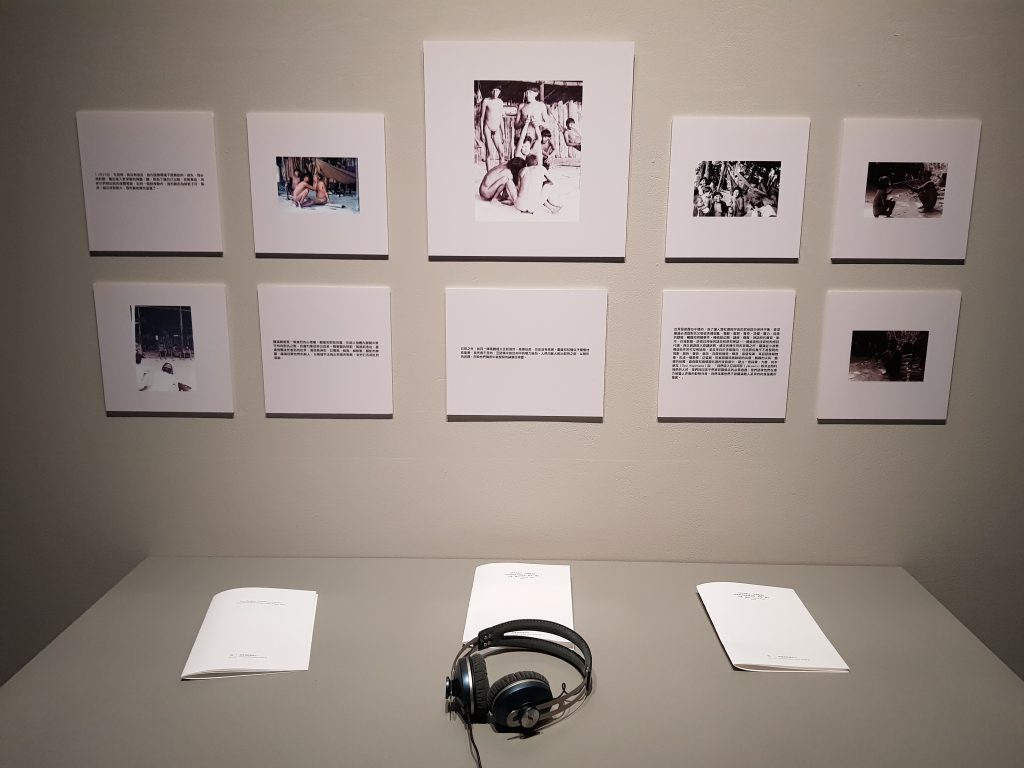
The second room of the exhibition showcases works accompanied by visual or textual components that might not fall directly under the definition of audio documentaries. One of the most prominent is David Toop’s Lost Shadows: In Defence of the Soul – Yanomami Shamanism, Songs, Ritual, 1978, which still takes me by surprise despite having listened to its CD release many times before. Installed here with some photographs and an excerpt from the original accompanying text, Toop’s work restlessly unsettles its own veneer of ethnomusicological dedication. The recordist is eager to surrender to an ascetic, if not heroic, practice of listening: “Here I have no language. I am helpless in this environment. Lost, I must listen, in isolation moving through further depths of listening. I listen in order to move out of my body, to collect sounds and bring them back into my body, as an act of repair.” And yet, Toop is also conscious of the absurdity of his position, and ready to dispel exoticism about the Yanomamö:
There is none of the ‘group mind’ psychology or cohesion seen in cinematic ritual. Men chat and laugh together as if discussing the absurdity of life or perhaps the absurdity of the sound recordist […] What they have been saying is that the foreigners are stupid to want to record their music and they are going to trick us out of many gifts.
Deep in the Amazon jungles, lost in the thrall of phonographic capture, David Toop identifies and confronts a central problem of both anthropology and ethnomusicology, formulating a hypernaturalist critique of naturalism that can still be moved to most of the artworks surrounding me in the exhibition space: “To wait until a plane passes overhead or a motorbike vanishes over the horizon, to edit out intrusions or to move away from unwanted noise before pressing the record button is to be the author of a highly selective idealised representation of an event”.
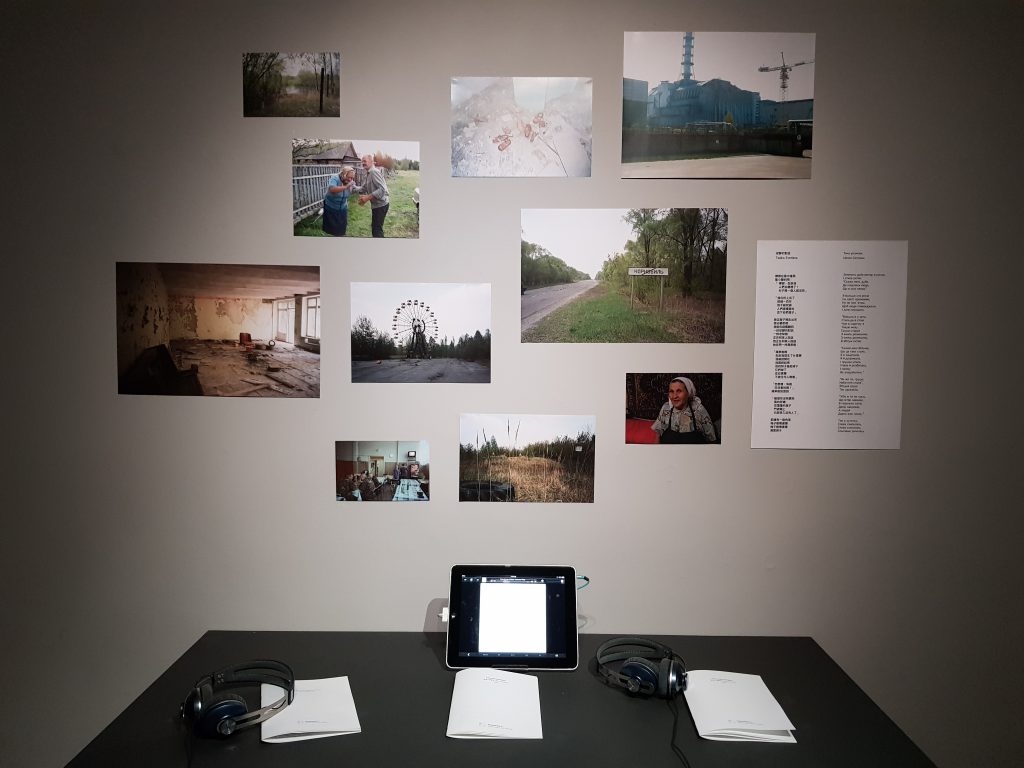
On the opposite side of the room, in a similar arrangement of photographs, booklets and headphones, is something I wanted to properly listen to for a long time: Peter Cusack’s Sounds from Dangerous Places. Undoubtedly the most interesting work of the whole exhibition, Cusack’s exemplar of sonic journalism embodies the paradox at the heart of the naturalist onto-episteme. As increasingly affordable recording devices and convenient digital distribution extend the reach of field recordists, the phonographer feels forced to push naturalist capture outwards, into places that are harder and more dangerous to reach – in Cusack’s case, disaster areas, nuclear sites and military zones characterized by “extreme or hostile conditions”. Based on two trips to Chernobyl’s exclusion zone in 2006 and 2007, Cusack’s work is a fascinating portfolio of minor voices and material details that avoids exploiting the eeriness of disaster porn and challenges the established boundaries of acoustic fidelity by including radiometer clicks, the electric crackling of generators, and the radioactive hiss of contaminated washing machines. “What can we learn by listening to the sound of dangerous places?”, Cusack asks. The answer emerging from his work falls unsurprisingly back onto familiar themes: that unchecked technological development encroaches upon traditional ways of life, that nature comes back by recolonizing an “undisturbed haven” in disaster’s wake, and that local knowledge wisely speaks “of a relationship between humans and nature that is utterly interdependent” – it is hard to disagree, but easy to want more.
At this point, my critique of sonic naturalism should be either clear or easily dismissed. Many of the works exhibited in KINO-EAR that I haven’t yet mentioned exemplify the naturalist onto-episteme to some degree, either by presenting recorded sounds as a neutral documentation of natural acoustic events, or by promoting listening as an unmediated way of knowing the world. The most evident marker of this framing is perhaps the aestheticization of remoteness: in Philip Samartzis’s Antarctica, an Absent Presence, field recordings captured in the South Pole are described as “a ghostly topography, a reinvention of the place, marked by a strong sense of absence, empty and white, deserted and silent”; while admitting that Antarctica is often stereotypically portrayed as the final wild frontier, Samartzis argues for phonography’s purchase on truth-seeking: “Antartica requires an interrogation about its untold secrets, which conceals a more accurate version of the truth”. Cédric Anglaret and Nicolas Perret’s Suania, a field recording work about Europe’s highest inhabited region, justifies its existence by connecting acoustic remoteness to ontological distance: “these beliefs and the still very traditional way of life are the pillars of a unique soundscape in which the harsh and spectacular natural environment echoes the ritual chants and ceremonies”. Luckily, a quirky audiovisual work looping on a small screen offers an ironic escape route from the naturalist trappings of harsh environments and uncontaminated traditions: Félix Blume’s #19 SON SEUL / WILD TRACK #1-19 is a collection of short videos depicting the sound engineer as he records “lonely sounds” to be used in the post-production of movies and documentaries, and it successfully foregrounds the absurdity and contrivedness of what, as listeners, we might confidently categorize as a “natural” sound.
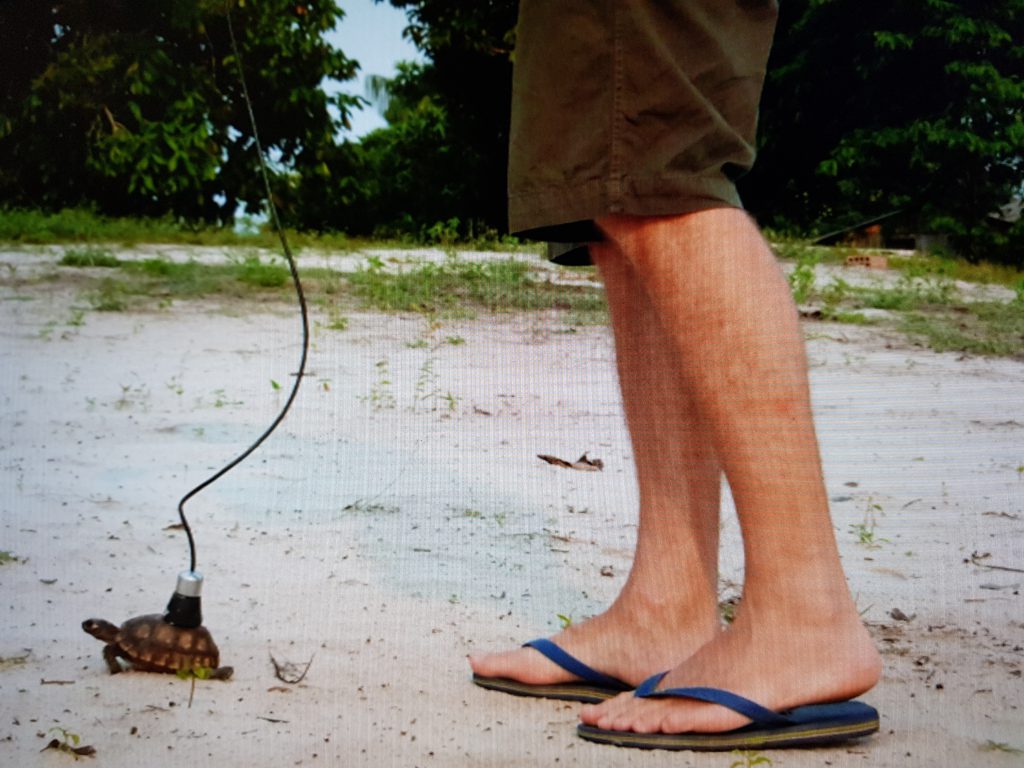
Drawing me into hours of listening, watching and reading, the KINO-EAR exhibition generously nudged me into engaging with the vocabulary of field recording and wringing out a critique of sonic naturalism, of which this is anything but its most cogent version. What kept bugging me, as I slowly moved from pillow to chair to stool, was the striking contrast between the title of this exhibition and the cinematic mobility invoked by the “kino-” prefix as used by Tziga Vertov in compounds like “kino-eye” and “kino-pravda” to characterize a non-documentary constructivism working against both representation and narrative. Sonic naturalism and its onto-episteme, still current in much phonography, seem to run counter to Vertov’s proposition to capture things that escape the human auditory sensorium by provoking the field through the introduction of a non-human ear. Before things get confusing, Jean Rouch’s reading of Vertov himself might help closing the circle:
The field changes the simple observer. When he works, he is no longer one who greeted the oldtimers at the edge of the village; to take up again Vertovian terminology, he “ethno-looks,” he “ethno-observes,” he “ethno-thinks,” and once they are sure of this strange regular visitor, those who come in contact with him go through a parallel change, they “ethno-show,” they “ethno-speak,” and, ultimately, they “ethno-think.” (Jean Rouch, quoted in Stoller, 1992)
The field changes the simple recordist too, and this perhaps is a good starting point to move from a critique of sonic naturalism to the articulation of postnaturalism, antinaturalism and unnaturalism in sound.
References:
Feld, Steven (2017). “On Post-Ethnomusicology Alternatives: Acoustemology”, in F. Giannattasio & G. Giuriati (eds.), Perspectives on a 21st century comparative musicology: Ethnomusicology or transcultural musicology?, Udine, Italy: Intersezioni Musicali (pp. 83-98).
Stoller, Paul (1992). The cinematic griot: The ethnography of Jean Rouch. Chicago, IL: The University of Chicago Press.
Experimental ethnography: 31 prompts | 实验民族志:31个提示
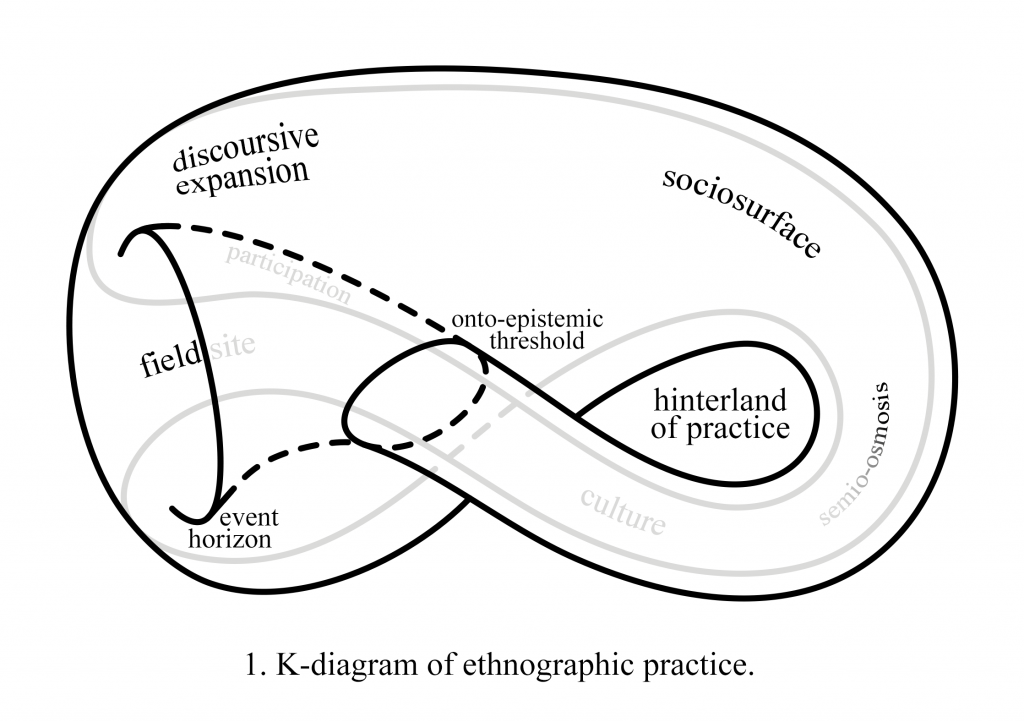
➰ Not all experimentation is ethnographic. Not all ethnography is experimental. The intersection of ethnography and experimentation collapses into a black hole with a fluctuating event horizon, swallowing both researcher and informants, raw data and research outputs. Once you find yourself trapped in its gravity well, memento extendi – remember to stretch as a strand of infinitely spaghettified matter.
➰ The term ‘experimental’ is deployed here in parallel with experimental art, experimental cinema, experimental literature, experimental music, experimental poetry and experimental theater, and is orthogonal to scientific experimentation. Concern yourself with the processual articulation of doing rather than with the empirical demonstration of theories.
➰ Experimental ethnography asks: “what else could ethnography be?”. Answer this question through practice.
➰ Experimentation indexes an act with unknown outcomes rather than empirical truth-making. Evade the formulation of research plans and expected results; collapse the distinction between research design and creative process until any speculative proposal becomes a practical beginning.
➰ Camouflaged behind a four-field ontology of structural, poststructural, destructural and constructural theories, experimental ethnography disappears into infrastructural interstices. Rely on its hidden dimensionalities, its base materialisms, its diminutive apprehensions, its cunning affordances.
➰ Experimental ethnography is neither before, nor after, nor against method. If methodology is a travel guide to research methods, experimental ethnography is aimless wandering in the hinterland of practice. Feel free to find shelter in case of epistemological precipitations.
➰ Resist the disciplinary injunction to reveal and excuse your research methods. Justify your methodology through provocation, sneak back epistemological conclusions in from the backdoor of experience.
➰ Fail.
➰ Experimental ethnography does not necessarily rely on the freedoms of improvisational research. Give yourself restrictions, then redouble them. Try to avoid indulging in the self-congratulatory pleasures of deep hanging out until you understand their local value.
➰ There is no ethnos. You already belong to whatever tribe of unknowing experimental ethnographers your research proposal pulls together.
➰ Everything is –graphy: your writing has no exclusive grip on a world of symmetrical semiosis. Train your writing to wrap around other inscriptions.
➰ Escape your fieldsite. Once you get used to escaping, force yourself back into a fieldsite one scale smaller than the one you escaped from.
➰ The normative practice of participation presupposes a clear division between insideness and outsideness. Occupy instead a membranous position, inevitably trapped in-between belongings, a thin filtering device trained in semiotic osmosis.
➰ You’re most likely a kind and respectful ethnographer. Be as unethical as you can for an entire day, and accept all consequences of your actions. Re-evaluate your ethics in light of this.
➰ Not everything consents, responds and informs. Embrace unresponsiveness, rejection and nondisclosure as valuable forms of communication.
➰ Gift your authorial privilege to informants. Protect your authorial labor from more privileged informers.
➰ Lie.
➰ No matter how experimental, ethnography is always an enfolding of experience and representation. Invent new forms of recording, new writing machines, new representational genres, new ways of encoding and decoding.
➰ Ethnography is co-extensive with mediation. Flatten sprawling networks of media when they become self-explanatory, extricate sealed mystiques of immediacy when they become self-justifiying.
➰ Situating is a transitive action – don’t just account for situated knowledges and practices, but acknowledge and practice situations.
➰ Mix your metaphors to see if they revert into equivalences or create irreducibility: What if your research subject was your audience, your ethics were your fieldsite, your material culture was your epistemology, your ontology was your alma mater, your conclusions were your beliefs?
➰ Indulge in fractal self-reflexivity: take a fieldnote about taking a fieldnote about taking a fieldnote about taking a fieldnote about itself. Then trash it, and feel alright about it.
➰ When you feel contented with your self-reflexive insights, let someone else audit your confessions and consign them to irrelevance. Take in all embarrassment without pride.
➰ Experimental ethnography isn’t merely a cosmetic replacement of ethnographic work with artistic practice. Use one to unbalance the other until their disorderly stacking becomes a canon, then move on to other representational domains.
➰ Critique collaboration as your worst enemy. Offer instead delaboration as a pragmatic counter to the exploitation of inclusivity.
➰ Cry.
➰ Leave autoethnography alone and let it live up to its name: the only research method that can write about itself. It doesn’t need you.
➰ Since all ethnography is already sensory, challenge yourself to experiment with the selective withdrawal of senses and the composition of skewed sensoria.
➰ Collect all the descriptors that have ever been used before “ethnography” to brand its disciplinary variants, then try to focus on something that wouldn’t fall under the purview of any of them.
➰ Resist the temptation of wallowing in the eternal postponing of conclusions. End projects when they seem to finally have some promise. There’s no “ongoing” in ethnographic experimentation.
➰ As any other kind of experimental practice, experimental ethnography has an expiration date: the time of its own becoming tradition. Be aware that each attempt at theorizing it brings it closer to its end.